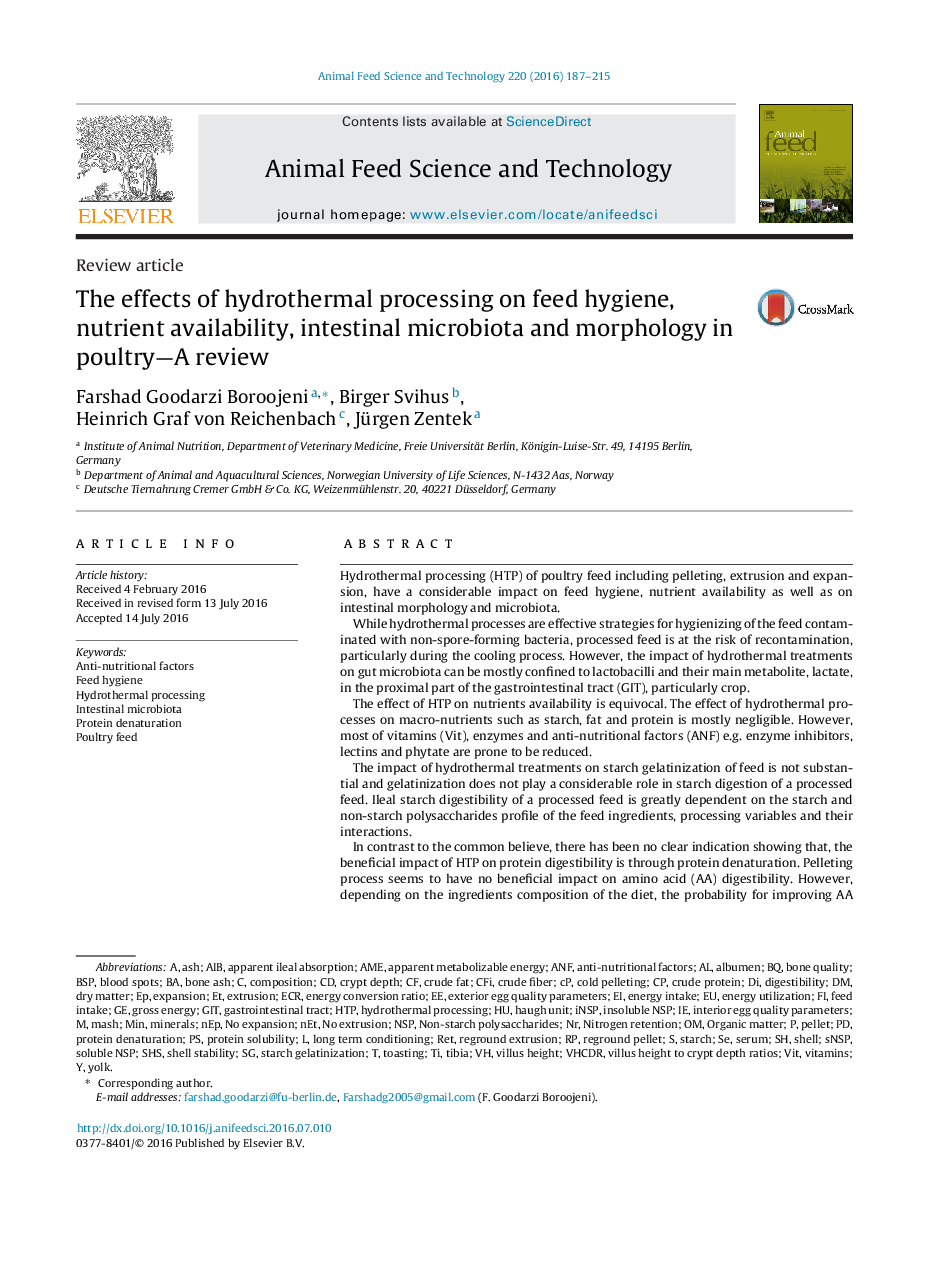| کد مقاله | کد نشریه | سال انتشار | مقاله انگلیسی | نسخه تمام متن |
|---|---|---|---|---|
| 2419252 | 1552365 | 2016 | 29 صفحه PDF | دانلود رایگان |
• Hydrothermal processing improves the hygiene status of poultry feed.
• Its effect on nutrients availability is equivocal.
• Its effect on starch and protein is mostly negligible.
• Anti-nutrients, added vitamins and enzymes are prone to be reduced by it.
• It may affect the morphology and microbiota of the gut.
Hydrothermal processing (HTP) of poultry feed including pelleting, extrusion and expansion, have a considerable impact on feed hygiene, nutrient availability as well as on intestinal morphology and microbiota.While hydrothermal processes are effective strategies for hygienizing of the feed contaminated with non-spore-forming bacteria, processed feed is at the risk of recontamination, particularly during the cooling process. However, the impact of hydrothermal treatments on gut microbiota can be mostly confined to lactobacilli and their main metabolite, lactate, in the proximal part of the gastrointestinal tract (GIT), particularly crop.The effect of HTP on nutrients availability is equivocal. The effect of hydrothermal processes on macro-nutrients such as starch, fat and protein is mostly negligible. However, most of vitamins (Vit), enzymes and anti-nutritional factors (ANF) e.g. enzyme inhibitors, lectins and phytate are prone to be reduced.The impact of hydrothermal treatments on starch gelatinization of feed is not substantial and gelatinization does not play a considerable role in starch digestion of a processed feed. Ileal starch digestibility of a processed feed is greatly dependent on the starch and non-starch polysaccharides profile of the feed ingredients, processing variables and their interactions.In contrast to the common believe, there has been no clear indication showing that, the beneficial impact of HTP on protein digestibility is through protein denaturation. Pelleting process seems to have no beneficial impact on amino acid (AA) digestibility. However, depending on the ingredients composition of the diet, the probability for improving AA digestibility by expansion and extrusion (HTST) processes can be considerable, especially when ingredients with high concentration of ANF are treated. Furthermore, the putative deleterious impact of the HTST processes on AA digestibility of poultry feed, through AA degradation and Maillard reactions, seems to be not pertinent.The harmful impact of the processes on the other thermolabile nutrients such as Vit cannot be ignored. There seems to be a lack of consistency in the effects of hydrothermal treatments on absorption, retention and deposition of minerals (Min) in poultry feed.Higher feed intake (FI) and passage rate (PR) usually coincide with feeding a hydrothermally processed diet. Increase in FI and PR, adversely affect nutrient availability for poultry. The direct effects of processing variables on starch, fat and protein digestibility, Min bioavailability and retention as well as digestive dynamics of starch and protein appear to be largely confounded with indirect impact of HTP through FI increment.The hydrothermal treatments, particularly the HTST processes, seem to increase fiber solubility and digesta viscosity which could lead to a negative impact on nutrient digestibility. However, reduction of ANF by these processes can have a positive impact on nutrient digestibility. Therefore the final outcome of HTP in terms of nutrient digestibility, is principally dependent on feed formulation, chemical composition of the feed ingredients or/and final feed, presence and concentration of ANF as well as hygiene status of the feed.
Journal: Animal Feed Science and Technology - Volume 220, October 2016, Pages 187–215
